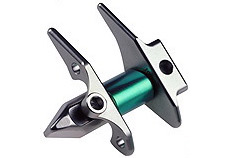X STOP INTERSPINOUS IMPLANT
Lumbar spinal stenosis is a common condition after age 50 through age 70. It is present in five of every 1,000 Americans over the age of 50. In Sweden , the mean annual rate of surgery for spinal stenosis is 9.7 per 100,000 inhabitants. In the United States , rates of surgery for this condition increased eightfold from 1979 to 1992 in patients over age 65.â€
What is Spinal Stenosis?
Spinal Stenosis is the shrinking or narrowing of the spinal canal. This narrowing of the canal can be congenital (present at birth) or more commonly occurs, as we grow older. As the spinal canal narrows, there is less room for the nerves to move freely. As a result, swelling and inflammation occurs, which can may cause pain. Arthritic changes, injury or surgery can also cause spinal stenosis.
Symptoms may progress slowly or occur as a sudden onset of pain. Spinal stenosis affects both males and females and is most common between the ages of 50 and 70. Individuals with spinal stenosis may experience vague pain in the low back and legs when walking or standing. Usually there is none to minimal pain with rest, sitting or laying down. Standing upright further decreases the space available for the nerve roots, and can block the outflow of blood from around the nerve. Congested blood then irritates the nerve and the pain travels into the legs. As the stenosis progresses, the symptoms increase with walking shorter distances.
WHAT IS IT?
X STOP is a new procedure that was developed by St. Francis Medical Technologies, Concord , California . X STOP is an alternative surgical procedure for patients with neurological symptoms (which are made worse in extension and relieved with flexion) from lumbar stenosis instead of other decompressive surgeries, such as, laminectomies or fusions. The surgery is minimally invasive and takes approximately an 30-45 minutes. This surgery can be performed as an outpatient procedure or the patient may stay overnight. Only local anesthesia is needed to perform this surgery. Another positive aspect of this surgery is that it is reversible.
IS IT APPROVED?
This procedure was approved in the USA by the FDA in November of 2005. However, the X STOP procedure has been available in Europe and Japan since 2001. It is estimated that X STOP has been implanted in roughly 7,000 patients.
X STOP DESIGN:
The X STOP is made out of high strength titanium alloy and consists of two major parts: the main body with an oval spacer and tissue expander and the wings. The oval body adjusts to the irregular surface of the spinous process by swiveling. This allows loads to be distributed equally on the bone without sharp edges contacting the spinous process. The wings restrict and prevent sideways and forward movement. Backward displacement is prevented by the supraspinous ligament which is still intact.
HOW IT WORKS:
The titanium spacer is imbedded between the spinous processes at the problematic level. The X-stop spacer in place puts that level into a slightly flexed position without causing flexion of the entire spine. Therefore, extension and nerve root impingement at that segment are prevented. Spinous processes have been tested on their ability to support the X STOP, and they have been proven capable of sustaining loads even in osteoporotic segments.
WHO IT IS USED FOR:
This treatment is for patients that have symptoms at one to two adjacent levels, experience extremities greater than axial pain, and get relief from sitting. Most patients are greater than 50 year old since this is the typical age people experience symptoms and seek treatment for lumbar stenosis. Currently, the X-stop is not indicated for patients with prior surgery and only a maximum of 2 levels can be preformed.
BENEFITS:
- No bone or soft tissue is removed.
- Patients do not receive general anesthesia. This is very beneficial of elderly patients. Since elderly patients typically have co-morbidities that can increase their risk of complications.
- Postoperative recovery is shorter.
- Decreased risk of complications.
- Reduced cost.
RECOVERY TIME:
The recovery time is essentially the same amount of time it takes the 2-3 inch incision to heal, which is approximately one-two weeks.
How do I complete my history?
Our patient portal (online) is the best method to complete your history and necessary documents. We would strongly recommend that you complete this form before your appointment time and date. At our office, we will have alternative methods to complete the forms, but those will be more time-consuming and may require that you arrive 1 hour before your appointment time.
Contact Us
13710 Olive Boulevard (Primary Office)
Chesterfield, MO 63017
Telephone: 314-469-PAIN (7246)
Fax: 314-469-7251
Exchange: 314-441-6965 (for after-hour Emergencies Only)
Hours:
Monday thru Friday
8:30 AM – 4:30 PM


